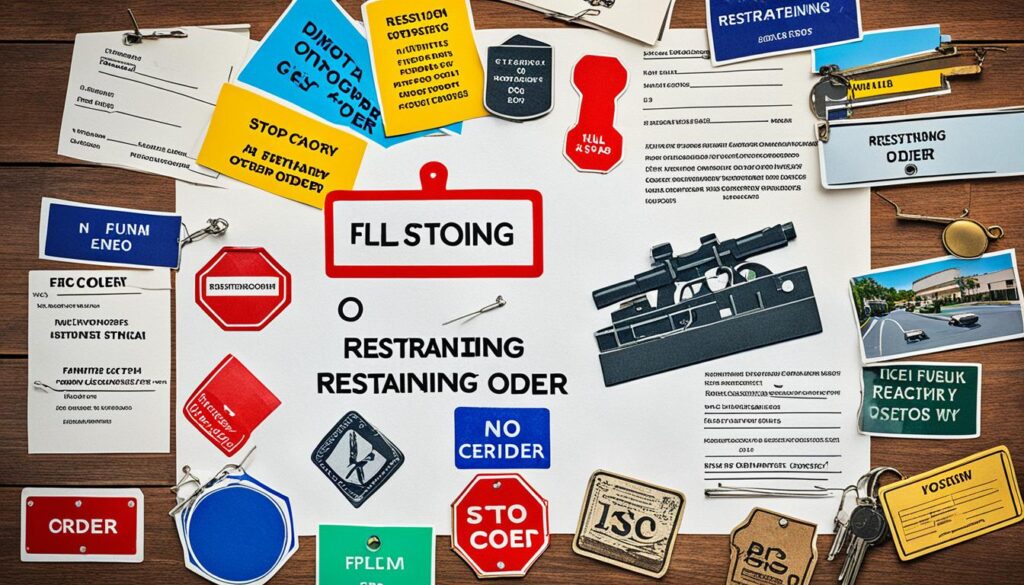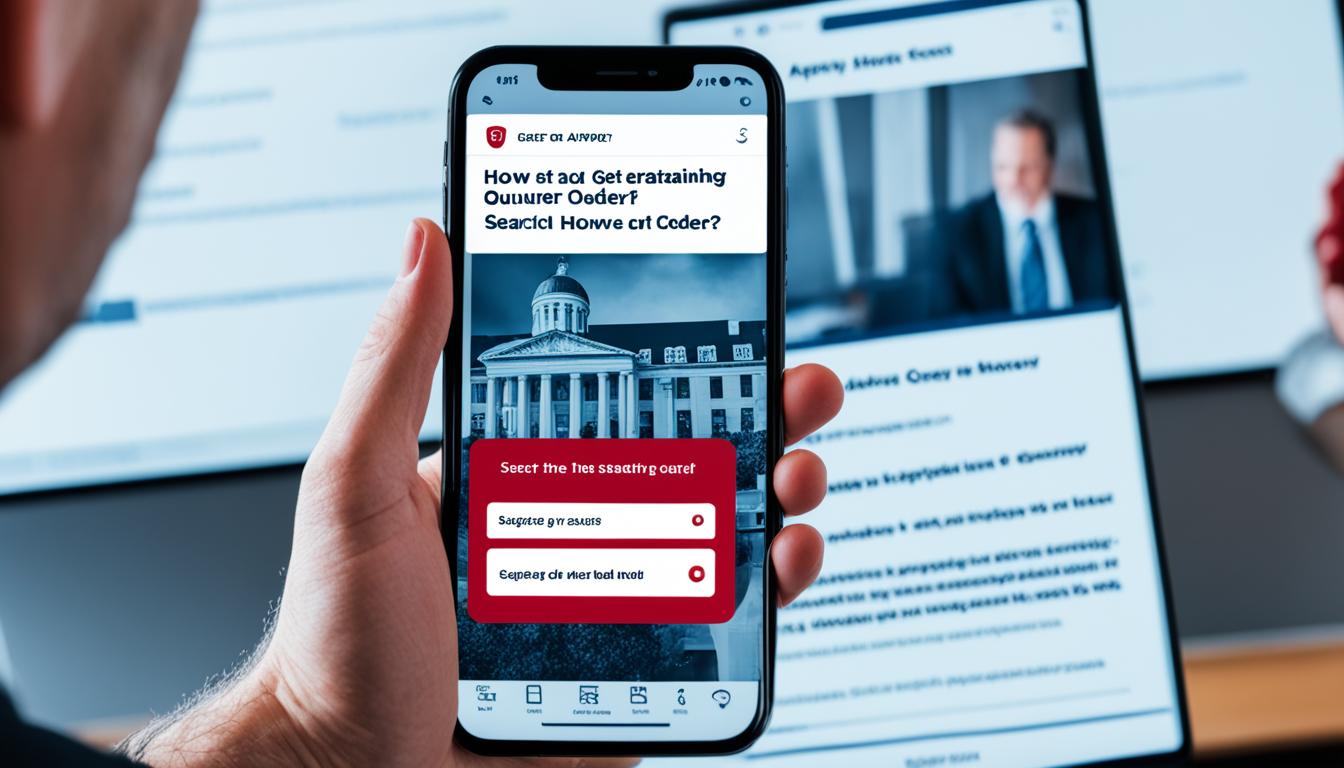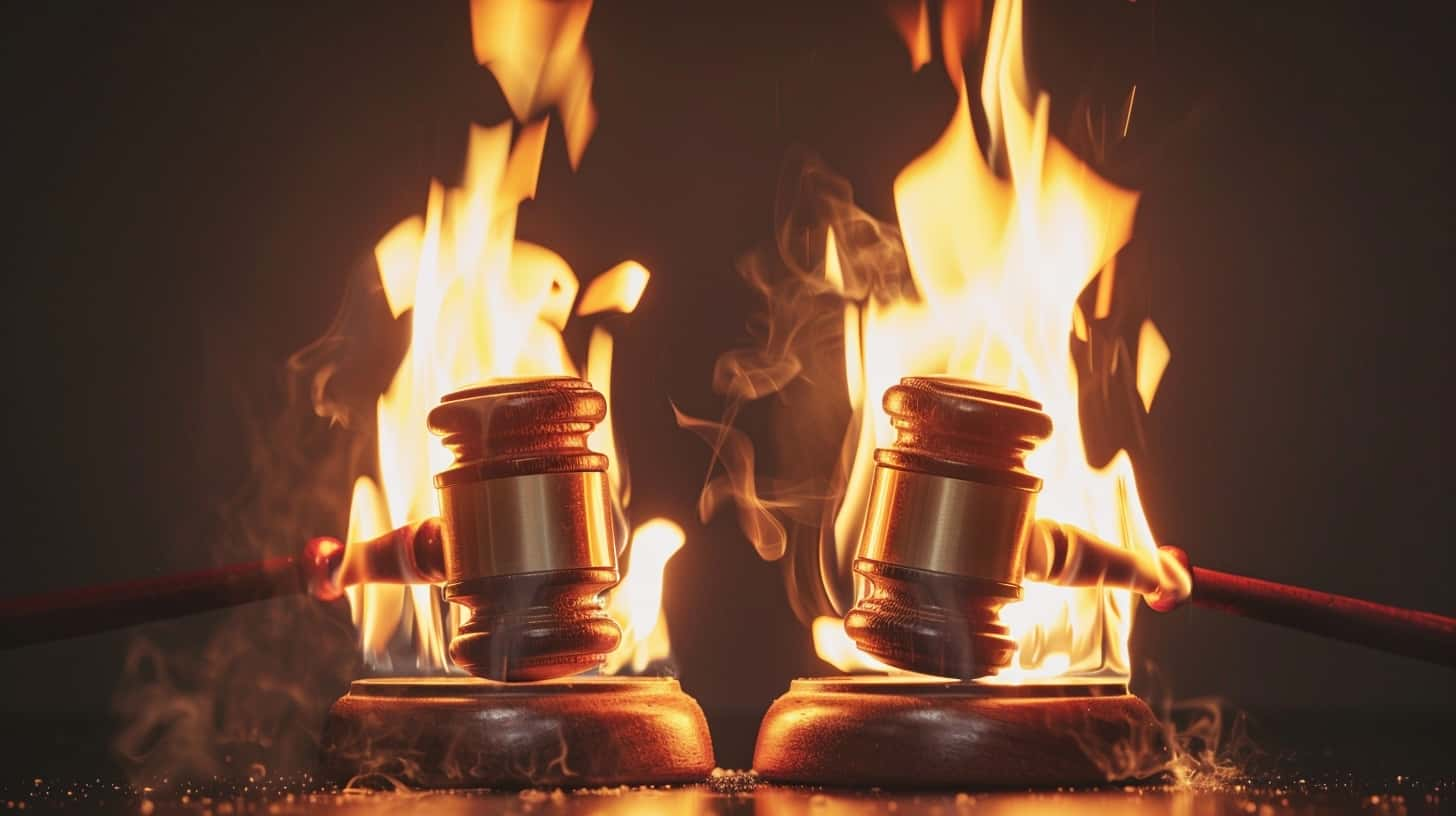Are you aware that getting a restraining order can lower the chance of violence by as much as 80%? If you have experienced physical violence or threats, obtaining a restraining order can offer legal protection and help guarantee your safety.
In Florida, these legal orders are known as “injunctions for protection,” and there are different types available depending on the nature of your situation. From domestic violence injunctions to stalking injunctions, there are options that can address your specific needs.
To navigate the process effectively, it’s essential to understand the steps involved. From filing the petition and completing the necessary forms to attending court hearings and enforcing the injunction, each step plays a critical role in obtaining and maintaining your restraining order.
Key Takeaways:
- Obtaining a restraining order can reduce the risk of violence by up to 80%.
- In Florida, restraining orders are known as “injunctions for protection.”
- There are different types of restraining orders, such as domestic violence injunctions and stalking injunctions.
- The process of getting a restraining order involves filing a petition, attending court hearings, and enforcing the injunction if granted.
- Keep copies of your injunction and report any violations to law enforcement.
What is a Restraining Order?
A restraining order, also known as an injunction for protection or order of protection, is a legal order that provides protection to someone who has been a victim of physical violence or threatened with violence. In Florida, these orders are called “injunctions for protection.” They can prohibit the restrained person from contacting the petitioner, going to their home or workplace, or possessing firearms. Violation of a restraining order can result in additional restrictions, contempt of court charges, or criminal charges.
Restraining orders serve as a crucial tool to ensure the safety and well-being of individuals facing threats or violence. The court-ordered restrictions imposed by a restraining order can provide a sense of security and peace of mind for those who fear for their safety.
**Restraining orders**, also commonly referred to as **injunctions for protection** or **orders of protection**, are legal documents that help protect individuals who have experienced or are at risk of experiencing physical violence or threats. In the state of Florida, these orders are known as injunctions for protection. They are designed to establish legal boundaries and prevent contact between the restrained person and the petitioner.
Restraining orders can include a range of provisions, such as prohibiting the restrained person from contacting the petitioner, coming near their home or workplace, or possessing firearms. These restrictions aim to create a safe and secure environment for the petitioner and ensure their well-being. Violation of a restraining order can have serious consequences, including additional restrictions, contempt of court charges, or even criminal charges.
Protection and Safety
Restraining orders provide a legal framework to protect individuals who have experienced or are at risk of experiencing physical violence or threats. The restrictions outlined in a restraining order can help prevent further harm and provide a sense of security for the petitioner.
“A restraining order can be a lifeline for someone facing domestic violence or other threats. It establishes clear boundaries and consequences for the restrained person, helping to keep the survivor safe.” – Legal expert
By enforcing strict boundaries between the petitioner and the restrained person, restraining orders can significantly reduce the risk of further violence or harassment. They create a legal basis for holding the restrained person accountable for their actions and protect the petitioner’s physical and emotional well-being.
Types of Restraining Orders in Florida
Restraining orders in Florida come in various types, each designed to address specific circumstances and relationships. Understanding the different types of restraining orders is essential when seeking legal protection against domestic violence, repeat violence, dating violence, sexual violence, or stalking. By knowing which type of restraining order is appropriate for your situation, you can ensure that you are taking the necessary steps to protect yourself.
1. Domestic Violence Injunctions
Domestic violence injunctions are intended for individuals who have a family relationship with the restrained person. These relationships can include spouses, former spouses, parents, children, or other family members who live together or have lived together in the past. To obtain a domestic violence injunction, you must demonstrate that you have been a victim of domestic violence or are in imminent danger of becoming one.
2. Repeat Violence Injunctions
Repeat violence injunctions are designed specifically for victims of repeat violence situations, where two or more incidents of violence have occurred. These incidents may involve physical harm, the threat of physical harm, or stalking, and can take place between individuals who are not necessarily in a domestic or family relationship. To qualify for a repeat violence injunction, you must provide evidence of the repeated violence you have experienced.
3. Dating Violence Injunctions
Dating violence injunctions are applicable to individuals involved in a romantic or intimate relationship. These injunctions provide protection against dating violence, which includes any incident of violence or the imminent threat of violence committed by a person who is or has been in a romantic or intimate relationship with the petitioner. Dating violence injunctions are essential for those who have experienced violence or are at risk of violence in a dating relationship.
4. Sexual Violence Injunctions
Sexual violence injunctions are specifically for victims of sexual violence. These injunctions can be obtained when a person has been a victim of any incident of sexual violence or when there is a significant threat of physical harm resulting from sexual violence. It is important to note that sexual violence injunctions can be pursued even if there are no criminal charges pending against the accused perpetrator.
5. Stalking Injunctions
Stalking injunctions are designed for individuals who have been victims of stalking behavior. Stalking refers to any willful, malicious, and repeated following, harassing, or cyberstalking that causes significant emotional distress to the victim. To obtain a stalking injunction, you need to demonstrate that you have been a victim of stalking or are in imminent danger of becoming one.
By understanding the types of restraining orders available in Florida, you can determine which one best applies to your situation and take the necessary steps to seek legal protection. Whether you are a victim of domestic violence, repeat violence, dating violence, sexual violence, or stalking, the restraining order process provides a legal avenue to ensure your safety and well-being.

| Restraining Order Type | Description |
|---|---|
| Domestic Violence Injunctions | Protects individuals who have a family relationship with the restrained person |
| Repeat Violence Injunctions | For victims of repeat violence situations |
| Dating Violence Injunctions | Applicable to individuals in a romantic or intimate relationship |
| Sexual Violence Injunctions | Specifically for victims of sexual violence |
| Stalking Injunctions | Designed for victims of stalking behavior |
Steps to Get a Restraining Order in Florida
Obtaining a restraining order in Florida involves several important steps. By following these guidelines, you can navigate the process effectively and increase your chances of obtaining the protection you need.
Determine the Type of Restraining Order
First and foremost, assess your situation and determine which type of restraining order is appropriate. Florida recognizes various types of restraining orders, such as domestic violence injunctions, repeat violence injunctions, dating violence injunctions, sexual violence injunctions, and stalking injunctions. Choose the one that accurately reflects your circumstances.
File Your Petition
Once you’ve identified the type of restraining order you need, it’s time to file your petition. Determine where to file based on various factors such as where you live, where the abuser resides, or where the domestic violence occurred. You have the option to file your petition electronically, by mail, or in person.
Obtain and Complete the Necessary Forms
After filing your petition, you will need to obtain the appropriate forms. These forms can usually be found at the clerk of the circuit court in your county. Take the time to carefully and accurately complete the forms, ensuring all required information is provided.
Submit Your Forms and Await a Court Ruling
Once you’ve completed the necessary forms, submit them to the court. The court will review your petition and issue one of three possible orders: a temporary injunction and an order setting a final hearing, a denial of the temporary injunction and an order setting a final hearing, or a denial of the petition. The court will inform you of the ruling and provide further instructions.
Prepare for and Appear in Court
If the court schedules a final hearing, it’s crucial to prepare for your court appearance. Collect any evidence or documents that support your case, such as police reports, medical records, or witness statements. Be prepared to present your case to the court, providing clear and concise testimony.
Understand and Enforce the Injunction
If the court grants your petition and issues an injunction, it’s essential to fully understand its provisions. Take the time to review the terms of the injunction and ensure you are aware of any restrictions or requirements. Familiarize yourself with the steps needed to enforce the injunction and seek legal assistance, if necessary.
Filing for an Injunction for Protection against Domestic Violence in Florida
To file for an injunction for protection against domestic violence in Florida, individuals need to follow the proper steps and procedures. The first step is to go to the clerk of the circuit court in the county where they currently live, where the abuser resides, or where the domestic violence incident occurred. The clerk of the circuit court is the appropriate authority to provide the necessary forms and instructions for filing a petition for an injunction.
It is important to note that filing for an injunction for protection does not require any fees. The process is accessible to everyone who needs legal protection from domestic violence. When filing the petition, individuals should ensure they have some form of identification, such as a driver’s license or picture ID, as it may be required by the clerk of the circuit court.
Additionally, victims of domestic violence can seek assistance and guidance from domestic violence organizations. To find a list of domestic violence organizations and shelters, individuals can refer to the state’s advocates and shelters page. These organizations can offer support through the filing process and provide valuable resources to help victims of domestic violence.
By following the necessary steps and seeking assistance when needed, victims of domestic violence in Florida can take the necessary legal measures to protect themselves and regain control of their lives.
Effectiveness and Benefits of Restraining Orders
Despite being referred to as “just a piece of paper,” restraining orders can be effective in reducing the risk of violence and providing protection to the survivor. Studies have shown that having a permanent order of protection in effect can lead to an 80 percent reduction in police-reported violence in the next year. Restraining orders can restrict abusers from contacting, threatening, or interfering with the survivor, and may also require the surrender of firearms, prohibit entry into the survivor’s residence, and protect custody arrangements. While there are cases where abusers may not take restraining orders seriously, **they have been shown to be effective overall** in increasing safety.

Reducing the Risk of Violence
Restraining orders play a crucial role in reducing the risk of violence. By legally prohibiting abusers from making contact with the survivor, restraining orders create a clear boundary that helps keep the survivor safe. This can significantly reduce the chances of physical violence or further harm.
Moreover, restraining orders can also help prevent emotional and psychological abuse by preventing the abuser from threatening, intimidating, or harassing the survivor. This can provide much-needed relief and peace of mind to the survivor.
Providing Legal Protection
One of the key benefits of restraining orders is the legal protection they offer to survivors. When an order is granted, it becomes enforceable by law. This means that if the abuser violates the terms of the restraining order, they can face legal consequences, such as fines or even jail time.
Restraining orders can also address specific concerns and provide tailored protection to survivors. For example, an order may require the abuser to surrender firearms, prohibiting their access to weapons that could be used to inflict harm. Additionally, restraining orders can ensure that the survivor’s residence is off-limits to the abuser, creating a physical barrier of safety.
Protecting Custody Arrangements
Another important benefit of restraining orders is their ability to protect custody arrangements in cases involving children. Restraining orders can outline specific provisions to ensure the safety and well-being of the children involved.
For instance, an order may grant the survivor sole custody or establish supervised visitation for the abuser. These provisions help create a safe environment for the children and prevent the abuser from using access to the children as a means of control or manipulation.
“Restraining orders provide essential protection by legally preventing abusers from contacting, threatening, or interfering with survivors, reducing the risk of violence and enhancing their overall safety.” – Jane Williams, Domestic Violence Advocate
While it is important to acknowledge that restraining orders may not guarantee complete safety in all cases, **they have proven to be effective in increasing the survivor’s safety and reducing the risk of violence**. It is crucial for survivors to take full advantage of the resources and legal protections available to them.
Types of Restraining Orders and Their Provisions
Restraining orders provide essential protection for survivors of abusive relationships, stalking, and sexual assault. In Florida, there are different types of restraining orders, each designed to address specific circumstances and provide the necessary legal safeguards.
1. Domestic PPOs (Personal Protection Orders)
Domestic PPOs offer protection to survivors who have or had a personal relationship with their abuser. These orders are crucial in situations where the survivor is at risk of physical violence or threats within a domestic setting. Domestic PPOs aim to keep the survivor safe by prohibiting the abuser from contacting them, entering their home, or approaching their workplace.
2. Stalking PPOs (Personal Protection Orders)
Survivors who are targeted by individuals they do not have a personal relationship with but who engage in stalking behavior can seek protection through stalking PPOs. Stalking is a pattern of unwanted behavior that instills fear and distress in the survivor’s life. These orders can impose restrictions on the stalker, such as keeping a certain distance from the survivor, refraining from any contact, and barring them from specific locations.
3. Sexual Assault PPOs (Personal Protection Orders)
Sexual assault PPOs provide protection for survivors who have experienced threatening sexual behavior. These orders are essential in cases where the survivor fears future acts of sexual violence or intimidation. Sexual assault PPOs impose restrictions on the abuser’s contact with the survivor, prohibiting any form of communication or interaction. They can also prevent the abuser from approaching the survivor’s home, workplace, or other relevant locations.
Restraining orders can include various provisions that ensure the survivor’s safety:
- Restricting the abuser’s contact with the survivor
- Barring the abuser from certain locations
- Requiring the abuser to surrender firearms
- Granting custody of shared children
These provisions are put in place to reduce the risk of further harm and provide survivors with the necessary protection they need to reclaim their lives.

| Type of Restraining Order | Applicability | Provisions |
|---|---|---|
| Domestic PPO | Abusers with personal relationships to the survivor | Restricts contact, bars entry to specific locations, surrender of firearms, custody arrangements |
| Stalking PPO | Stalkers without personal relationships | Restricts contact, maintains distance, bars entry to specific locations |
| Sexual Assault PPO | Threatening sexual behavior | Restricts contact, bars entry to specific locations |
Steps to Get a Restraining Order and Representation in Court
Obtaining a restraining order involves several essential steps to ensure your safety and legal protection. Whether you’re looking to obtain a temporary order or pursue a permanent protection order, it’s crucial to understand the process and necessary actions.
1. Obtaining a Temporary Order of Protection
The first step in getting a restraining order is typically obtaining a temporary order of protection. This initial order can be obtained either at the scene of a domestic violence incident or at the courthouse. It provides immediate protection while you proceed with the necessary legal steps.
2. Applying for a Permanent Restraining Order
Once you have obtained a temporary order, you can proceed to apply for a permanent restraining order. This may require a hearing, during which you will present your case and provide supporting evidence. It’s essential to gather all relevant information and documentation to strengthen your case.
3. Preparing the Necessary Paperwork
Properly preparing the required paperwork is crucial in successfully obtaining a restraining order. Take the time to accurately fill out all necessary forms, ensuring that you provide all essential details and information.
4. Assembling Evidence and Witnesses
Gathering evidence is key to substantiating your claims and strengthening your case. Collect any relevant documentation, such as police reports, medical records, or witness statements, to support your request for a restraining order.
Witnesses can also play a significant role in supporting your case. Identify individuals who have firsthand knowledge of the violence or threats you have experienced and ask them to provide testimony or statements.
5. Representing Yourself in Court
While having legal representation is ideal, representing yourself in court is also an option. If you choose to do so, it’s crucial to familiarize yourself with the necessary legal procedures and present your case confidently and professionally.
6. Getting Legal Representation
If you require legal representation but cannot afford a lawyer, free legal services may be available to assist you. Reach out to local domestic violence organizations and state coalitions for guidance and support throughout the process.
Remember, the process of obtaining a restraining order can be challenging, but there are resources and support available to help you through it. By following these steps, carefully preparing your case, and understanding the legal requirements, you can take the necessary actions to protect yourself from physical violence or threats.
Conclusion
Obtaining a restraining order is a critical step in protecting yourself from physical violence or threats. By following the necessary steps, accurately completing the forms, attending court hearings, and understanding the provisions of the injunction, you can increase your safety and seek legal protection. It may be a challenging process, but there are resources available to help navigate the legal system and ensure that your rights are protected.
Remember to keep copies of your injunction and report any violations to law enforcement. By doing so, you take an active role in safeguarding yourself and creating a safer environment. A restraining order can provide peace of mind and empower you to assert your rights.
If you find yourself in a situation where you need to obtain a restraining order, don’t hesitate to seek support from local domestic violence organizations, legal aid services, and state coalitions. These organizations can provide valuable guidance and support throughout the process. Protecting yourself is essential, and you have the right to seek legal protections that help ensure your safety.










